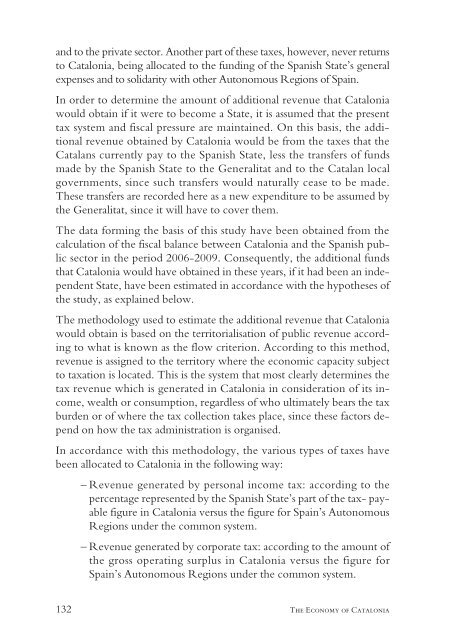The Economy of Catalonia
the_economy_of_catalonia._questions_and_answers_on_the_economic_impact_of_independence
the_economy_of_catalonia._questions_and_answers_on_the_economic_impact_of_independence
Create successful ePaper yourself
Turn your PDF publications into a flip-book with our unique Google optimized e-Paper software.
and to the private sector. Another part <strong>of</strong> these taxes, however, never returns<br />
to <strong>Catalonia</strong>, being allocated to the funding <strong>of</strong> the Spanish State’s general<br />
expenses and to solidarity with other Autonomous Regions <strong>of</strong> Spain.<br />
In order to determine the amount <strong>of</strong> additional revenue that <strong>Catalonia</strong><br />
would obtain if it were to become a State, it is assumed that the present<br />
tax system and fiscal pressure are maintained. On this basis, the additional<br />
revenue obtained by <strong>Catalonia</strong> would be from the taxes that the<br />
Catalans currently pay to the Spanish State, less the transfers <strong>of</strong> funds<br />
made by the Spanish State to the Generalitat and to the Catalan local<br />
governments, since such transfers would naturally cease to be made.<br />
<strong>The</strong>se transfers are recorded here as a new expenditure to be assumed by<br />
the Generalitat, since it will have to cover them.<br />
<strong>The</strong> data forming the basis <strong>of</strong> this study have been obtained from the<br />
calculation <strong>of</strong> the fiscal balance between <strong>Catalonia</strong> and the Spanish public<br />
sector in the period 2006-2009. Consequently, the additional funds<br />
that <strong>Catalonia</strong> would have obtained in these years, if it had been an independent<br />
State, have been estimated in accordance with the hypotheses <strong>of</strong><br />
the study, as explained below.<br />
<strong>The</strong> methodology used to estimate the additional revenue that <strong>Catalonia</strong><br />
would obtain is based on the territorialisation <strong>of</strong> public revenue according<br />
to what is known as the flow criterion. According to this method,<br />
revenue is assigned to the territory where the economic capacity subject<br />
to taxation is located. This is the system that most clearly determines the<br />
tax revenue which is generated in <strong>Catalonia</strong> in consideration <strong>of</strong> its income,<br />
wealth or consumption, regardless <strong>of</strong> who ultimately bears the tax<br />
burden or <strong>of</strong> where the tax collection takes place, since these factors depend<br />
on how the tax administration is organised.<br />
In accordance with this methodology, the various types <strong>of</strong> taxes have<br />
been allocated to <strong>Catalonia</strong> in the following way:<br />
– Revenue generated by personal income tax: according to the<br />
percentage represented by the Spanish State’s part <strong>of</strong> the tax- payable<br />
figure in <strong>Catalonia</strong> versus the figure for Spain’s Autonomous<br />
Regions under the common system.<br />
– Revenue generated by corporate tax: according to the amount <strong>of</strong><br />
the gross operating surplus in <strong>Catalonia</strong> versus the figure for<br />
Spain’s Autonomous Regions under the common system.<br />
132 <strong>The</strong> <strong>Economy</strong> <strong>of</strong> <strong>Catalonia</strong>


